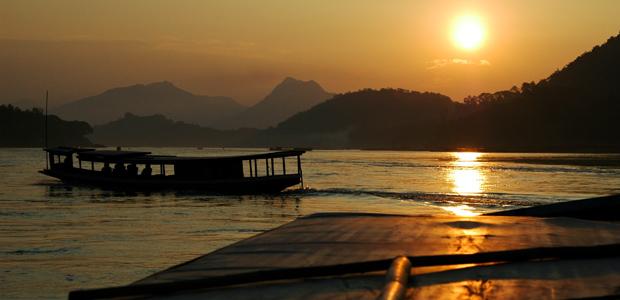Critics Worried About Dam Along Mekong River
Sunset at Mekong River (Photo: Irwin Loy)
In the sleepy town of Luang Prabang a Lao boatman dips a paddle into the Mekong River, promises tourists top-notch views of the Mekong’s iconic blood-red sunsets, and heads off downstream, propelled as much by the river’s flow as its engine.
The Mekong is one of the world’s great rivers. It has been a key to life in Laos and the rest of Southeast Asia for millennia. And like the boatman, Laos itself now hopes to harness its power. The country wants to build the first hydroelectric dam ever on the lower Mekong, which runs from the Chinese border to the South China Sea.
Landlocked Laos is one of the poorest and least-developed countries in Southeast Asia and authorities in the capital Vientiane say using the river to generate electricity is the only way forward.
Xaypaseuth Phomsouph, head of the Laos department of energy promotion and development, said Laos has been exploring its options for oil and gas development without much success, and that it has few other options for generating badly needed electricity.
“We have no other choice but hydropower,” he said.
Laos wants energy to become the main driver of the economy. And its plans are ambitious. The country already has 12 smaller hydro dams on Mekong tributaries, but it wants to build almost 70 more dams throughout the country, including nine on the Mekong itself.
However damming the Mekong is a risky and controversial move.
The Mekong’s swelling waters provide irrigation for thousands of square miles of farmland in five countries. And its fisheries are a food basket for millions, including fisherman Sleh Matly, who lives downstream in Cambodia.
“Fish are so important for me and my whole family,” Matly said as he squatted on the ground with his family, scraping the scales from a few Mekong fish.
His livelihood and those of his family and friends depend on these fish, he said.
“If I have fish, then I can sell it to buy rice and support my family. Ask anyone here. They’ll tell you the same thing.”
80 percent of Cambodia’s protein comes from fish, making it more dependent on the Mekong’s fish than any other Southeast Asian country. Conservationists say building even one dam on the lower Mekong could change the river forever, and put all those livelihoods in jeopardy.
Chhith Sam Ath, who runs a coalition of non-governmental organizations called the NGO Forum in Cambodia, believes that if Laos’s plans go ahead, “it’s going to be a disaster. It’s going to destroy the whole of the Mekong’s biodiversity system.”
Sam Ath said food from the Mekong is more than just part of Cambodia’s diet. It’s woven into the country’s culture–especially the pungent fermented fish paste known as prahok.
Every household in the Cambodian countryside uses prahok, he saids. “They could not cook without it. So when prahok is lost, it’s going to be a big loss. And that is going to destroy a culture.”
Scientists say mega-projects on the Mekong pose a direct threat to many of the river’s more-than one-hundred species of migratory fish. The Lao government has said it will build mitigation measures such as fish ladders into the dam, but fish ladders have fallen short of their mark elsewhere. And fish biologist Eric Baran of Cambodia’s WorldFish Centre said there are just too many question marks, and too few studies of how Mekong fish would actually be affected.
“When a mitigation measure is proposed on the mainstream, it’s actually not based on any testing,” he said.
Baran, who has studied Mekong fish for a decade, said the Mekong mainstream should not be used as a test-case for any technological development.
Meanwhile, other scientists are concerned that the impact wouldn’t be limited to fisheries. The dams would also trap vital silt and nutrients from flowing to agricultural land and coastal ecosystems downstream.
All of these concerns are making the debate over dams a contentious regional issue. Laos isn’t alone in wanting to tap the Mekong’s power–altogether there are eleven dams proposed by the five Lower Mekong countries, including two by Cambodia itself. But when Laos announced its plan to actually build the first one, Cambodia joined Vietnam and Thailand in voicing their concern and asking for further study.
Conservationists say that study should include an examination of alternatives to traditional mega-dams. They are pushing for networks of smaller, localized projects, including solar and wind power, and smaller hydropower projects on Mekong tributaries.
Gordon Congdon, of the conservation group WWF in Cambodia, said the big dams and massive national power grids being proposed in Laos represent the technology of the last century.
“We think there’s a much better energy future available to Cambodia, Laos, Vietnam and Thailand” than big hydropower, Congdon said.
But renewables are still in their infancy in Southeast Asia, and Lao officials say their potential doesn’t compare to hydro. Laos craves energy, and energy chief Xaypasueth Phoumsopha said the country can’t afford to wait.
“Most of our population is living under poverty,” he said. “We have no capacity to operate a nuclear power plant, or to construct a power plant importing gas or oil from the Middle East. Only hydropower.”
Laos, Cambodia, Thailand and Vietnam have all agreed to consult with each other before building a dam on the Mekong. But in the end, Laos says, the final decision to build the first dam on the lower Mekong will be its own.
Our coverage reaches millions each week, but only a small fraction of listeners contribute to sustain our program. We still need 224 more people to donate $100 or $10/monthly to unlock our $67,000 match. Will you help us get there today?
